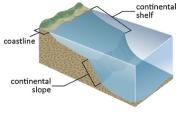Go offline with the Player FM app!
Changing Course
Manage episode 472851722 series 1022694

Currents at the bottom of the ocean can be just as fickle as wind currents at the surface. They can turn, speed up or slow down, and even reverse course. And they can change in just days or even hours.
That’s the conclusion of the most detailed study of sea-floor currents to date. Researchers anchored 34 instrument packages across a thousand-square-mile region off the coast of Mozambique, at the southeastern corner of Africa. The instruments monitored the currents for four years.
The study took place on the continental slope, at depths of up to a mile and a half. The slope is steep, and sharp canyons notch into it. Sediments tumble down the slope and through the canyons.
At the bottom of the slope, the currents generally flow from south to north. And in the canyons, they generally flow downhill. Speeds range from about a half to one-and-a-half miles per hour.
But researchers found a lot of variation. The speed changes, and so does the direction. Currents can even reverse direction—even in the canyons, where they sometimes flow uphill. Some of the changes are related to the tides or to passing storms or eddies. And others are related to the seasons, so they play out over days or weeks.
The researchers say a better understanding of sea-floor currents can tell them more about where ocean sediments come from. That can help them better understand changes in climate, the sources of pollution, and more—swirling along at the bottom of the sea.
161 episodes
Manage episode 472851722 series 1022694

Currents at the bottom of the ocean can be just as fickle as wind currents at the surface. They can turn, speed up or slow down, and even reverse course. And they can change in just days or even hours.
That’s the conclusion of the most detailed study of sea-floor currents to date. Researchers anchored 34 instrument packages across a thousand-square-mile region off the coast of Mozambique, at the southeastern corner of Africa. The instruments monitored the currents for four years.
The study took place on the continental slope, at depths of up to a mile and a half. The slope is steep, and sharp canyons notch into it. Sediments tumble down the slope and through the canyons.
At the bottom of the slope, the currents generally flow from south to north. And in the canyons, they generally flow downhill. Speeds range from about a half to one-and-a-half miles per hour.
But researchers found a lot of variation. The speed changes, and so does the direction. Currents can even reverse direction—even in the canyons, where they sometimes flow uphill. Some of the changes are related to the tides or to passing storms or eddies. And others are related to the seasons, so they play out over days or weeks.
The researchers say a better understanding of sea-floor currents can tell them more about where ocean sediments come from. That can help them better understand changes in climate, the sources of pollution, and more—swirling along at the bottom of the sea.
161 episodes
All episodes
×Welcome to Player FM!
Player FM is scanning the web for high-quality podcasts for you to enjoy right now. It's the best podcast app and works on Android, iPhone, and the web. Signup to sync subscriptions across devices.



